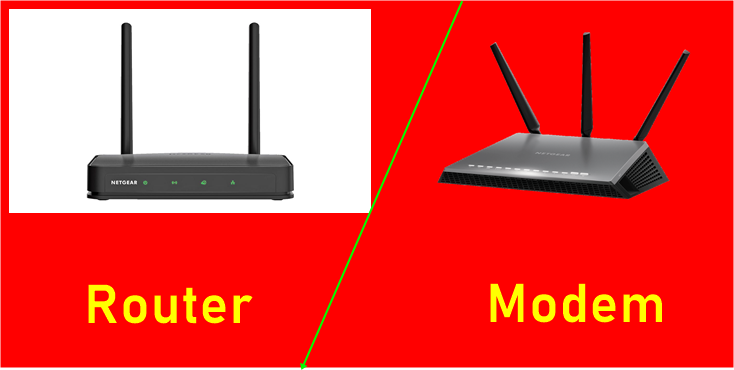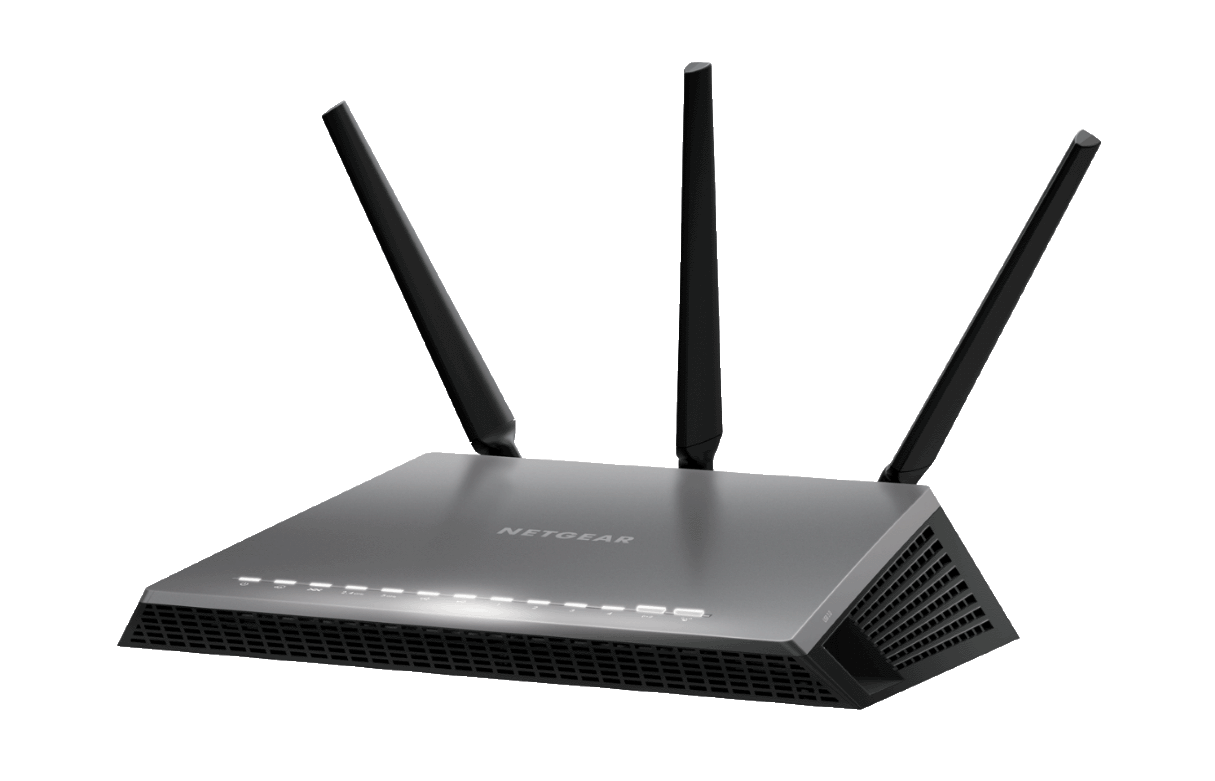Router vs. Modem: What is the Difference?
If you are wondering whether you need a router or a modem or simply want to know the difference between the two, this detailed post will help you make the decision.
Many often, people use them interchangeably, but technically, they are different from each other. However, there are modem router combos that can serve the purpose of these two.
If you are using the Internet at home, there are great chances you are using both of them.
Before we learn more about them, I’d like to tell you that Modem is used for connecting a computer to the internet however router is used for creating networks between the computers in your office or at home.

Let’s know them in detail and understand the difference between the router and the modem.
What is a Modem?
A modem stands for modulator/ demodulator. This means that it permits and assists data transmission on the Internet via cables in the format of Analog signals.
However, the problem lies in the fact that only electronic devices like computers and mobile phones understand and can interpret digital transmission.
This is where the function of the modem comes into play.
A modem functions as a translator and it modulates and demodulates the signals for the conversion of Analog signals to digital signals and vice-versa.
This helps in the communication of the Internet and different electronic devices. Both the cable as well as DSL internet connections work via a modem.
Functions at the transmitting end:
- Converting the data in binary form into Analog signals which can be interpreted
- Offering protection against overloading and other similar problems
- Send dialing signals, in case the model is designed to operate without the presence of the operator
Functions at the receiving end:
- Performing line control and signaling
- Putting demodulate into RS-232 format and further connecting to the RS-232 interface system
- Receiving the signals in the Analog form and interpreting them into digital signals
What is a Router?
The router can be defined as the link between the local network system and the Internet. With derivative IP addresses, a router can help to establish a link between multiple devices as well.
If there is only a single computer connected to the Internet, a router is not required. However, not all computers have an Ethernet port which is a necessity.
Along with that, it is common to see a dozen devices requiring an Internet connection in a regular office or home.
They cannot be directly connected with the help of a modem and need an intermediate device.
Routers are thereby functional to create a network and ensure connectivity within the network. Routers help in establishing connectivity amongst the devices as well.
The router is considered intelligent enough to selectively deliver quanta of data and information to multiple destinations.
Functions of the Router:
- Connecting to VPN
- Creating a Local Area Network, popularly known as LAN
- Connecting different media devices
- Running a firewall
- Packet filtering and forwarding
- Splitting up the Internet connection to all electronic devices
Home Networking
Modems are seldom used for high-speed networking applications that use orthogonal frequency-division multiplexing to modulate information for transmission.
The word “null modem” is generally used to describe attaching wired cables between the ports of your computer.
This procedure is performed by wiring the transit output to the input of the other computer.
Software such as Procomm and Minicom which are occasionally used to popularly used modems could also be used for the application of null modems.
Routers can operate on two types of network element components which are organized into planes.
They can be categorized as the control plane and forwarding plane. The Control plane initiates the use of internal preconfigures directives which are technically termed static routes.
The control plane strips the directives which are not extremely essential for the functioning and further builds up a forwarding information base.
The forwarding plane, on the other hand, forwards information and data between the different surface connections.
They are forwarded to the network types that suit them the most by using the cache data containing matched entries.
Types and Models
Modems and Routers have different types and models. Let’s find out.
Types of Modems
Modems can be classified into multiple numbers of categories. The dial-up modems use Analog telephone lines to connect the two ends of working systems.
It modulates the data in binary form to carrier signals for transmission. DSL modems use twisted-pair cables to radiate at higher frequencies.
They offer up to 2 Mbps or even much more, depending upon the configuration of the system.
Cable modems are designed to carry specific signals including television signals and radio signals.
By using telephone lines, mobile broadband modems function efficiently by being inserted inside the USB ports or internet access.
Also see: How to Remove idp.alexa.51 virus
Modems like half-duplex modems allow transmitting only one single signal at a particular instant of time in only one direction.
Full-duplex modems, on the other hand, allow the transmission to both directions, which means that they have two in-built carriers.
A four-wire modem uses similar frequencies for transmission on both ends because separate paired wires are used for transmission as well as acceptance of signals.
Types of Routers
Routers can be classified as wireless routers, bridge routers, distribution, or core routers. A wireless router has a combination of multiple base stations.
On the other hand, bridge routers allow interfaces with an Asynchronous Transfer Mode (ATM). This particularly helps in supporting several computers.
Distribution routers help in ensuring the quality of service across the WAN (Wide Access Area). This helps in aggregating the traffic sources from multiple access areas.
The core routers are essentially designed to work and operate in the backbone of the Internet networking system, also known as the core.
Advantages of the modem:
- Useful in connection of LAN (Local Area Network) with the Internet
- Cost determines the speed of the system
- Most widely used data communication roadway across the globe
- Allows end devices like PC or laptops to access the outside world
- Fewer maintenance costs
- USB modems are very cheap, compact, and easy to carry
Advantages of the router:
- Enables a reliable and sturdy network between the network hosts
- Delivers the packets of information and data in an organized manner
- Lowers the data load on the system
- Increases productivity to a considerable extent
- Offers high-speed data transmission and suits wired as well as wireless communication systems
- In-built security features to deal with virus attacks and network threats
- Access restriction features for storing sensitive data
- Secure storage with the network, username, password, and other credentials
- Master and slave modes working, thus shielding the network from a complete failure
How do they work?
Modem– The modem can only be connected to one device at a particular instant in time. They can also include LEDs to indicate that the unit is functioning properly.
The signals are also used to indicate data received from ISP (Internet Service Provider) and that the modem is successful in transmitting the packets of data and information.
Another LED indicates access to the Internet. Modems are generally used for coaxial cable connections.
DSL (Digital Subscriber Line) is typically much slower than broadband which is based on cable connections and is, therefore, not generally used by broadband.
Router– On the other hand, a router can establish connection amongst multiple devices through Ethernet cables or Wifi for cable as well as DSL connectivity.
Both types have several additional ports for Ethernet, which are used for wired devices. Such devices have a matching port or adaptor.
These devices can include laptops, HDTVs, printers as well as desktops, and gaming consoles.
These ports, if used as hardware connections, can prove to be extremely fruitful in the long run.
At times, this can also help to speed up the port’s support to up to one gigabit per second.
Application of Modem:
- Point of sale
Whenever any payment method is operated at restaurants, retail stores, and air tickets, modems work at the back end for approval or denial of the data and services requested.
- Remote management
Modems are used in red-light control areas and industrial inventory management areas. They can be mounted in interior o locations, which makes them functional without being physically present at the site.
- Security management
Modems are extensively used in security systems to send a voice message to the client over the telephone line or through the mobile if any issues suddenly arise.
Advantages of the Router:
- Data storage options
Routers are designed to be capable of storing sufficient data, whereas external devices can also be used for data backup options.
- Confidential servicing
Firewalls can be planted at every node of the network system to ensure that the network is virus-free.
These kinds of applications are generally associated with military purposes where data privacy is given supreme importance.
Router vs. Modem: Key Difference
- A modem modulates and demodulates Analog and digital signals whereas routers manage the data entering and leaving the networking system.
- The modem can be operated only on the data link layer, whereas routers can be operated at data link layers, network layers, or even a physical layer.
- The modem is capable of bringing the requested data from the Internet into your device, whereas routers assist in the distribution of information and data to connected electronic devices.
- The modem offers fewer security features and does not inspect the data packets. Routers on the other hand, compulsorily inspect data packets before forwarding them.
Integrated Modem and Router: Router Modem Combo
Nowadays, Internet Service Providers lease an integrated combination of modem and router to their customers, which is known as the gateway.
The modems can be purchased or easily rented. This combination also includes a VoIP function to ensure stability and durability in network conditions.
Alternatively, some ISPs also bundle up a package to offer more flexibility.
The use of an integrated modem and router also significantly helps in cutting down your monthly bills.
While the devices might be expensive in one go, they should be treated as a one-time investment, especially in comparison with the monthly fee of the ISP routers.
The flexibility in the installation of the modem and router combo package is one of its key signatures.
For the people who use wired broadband services, the modem router will help to optimize the Internet user experience as well.
The settings of the modem router combo can be fully customized according to your own needs and requirements with ease.
The enhanced security features which come along with the package are advanced in comparison to the ISPs.
The 3.1 security encryption improves online security to a considerable extent from hackers and other unsafe commodities.
Thus, the modem router package will help in delivering enhanced internet bandwidth possibilities.
Advantages of Combo Modem and Router system:
- Comparatively less clutter in network systems
- Fewer failure points in the network
- The device can be remotely managed by the ISP (Internet Service Provider)
- Less expensive than investing in a separate modem and router
- Easy installation and set-up
- Up-to-date security features
- A separate router and a modem are more expensive
- Affordable
Undoubtedly, this concludes that the modem router combo is a wise option to invest in if you are looking for long-run advantages and additional features to your network system.
The compilations available in the market can also help you to select the best modem router combo to suit your needs and requirements.
Comparison between a Modem and Router
| Modem
 | Router
 | |
| Layer | Datalink layer, which means that there are 2 layers | Datalink layer, network layer, and physical layer |
| Functions | Establishes a connection to the internet by the transmission and accomplishment of data through the telephone lines | Directs and passes the data in a network of home computers and between the computer and the modem |
| Ports
| 2 ports, one is for connection to ISP and the other one for connection with the router, in case of larger network areas | 2, 4, 5 or 8 ports, depending on the requirements
|
| Types of devices | Inter-networking devices | Networking devices as a whole |
| Connectivity | Can be connected to a PC using an Ethernet port | Can be connected to multiple PCs or other networking devices through Wi-Fi or Ethernet |
| The necessity of an Internet connection | Necessary | Not necessary (Provides extra features like additional security and multiple connectivities in case of Internet availability) |
| Security | No security measures | Provision of additional security measures |
| Independent functioning
| Can function without a router by delivering data and information to a single PC system | Cannot function without a modem as there would be no internet connectivity to share information between the computers |
Router vs. Modem: Wrapping up
While a router and modem are often referred to as separate entities, they are often combined into a single hybrid working device for user convenience, termed as gateways.
Irrespective of the facts mentioned, both systems have their advantages and disadvantages. A user must invest in the system as per the requirements.

